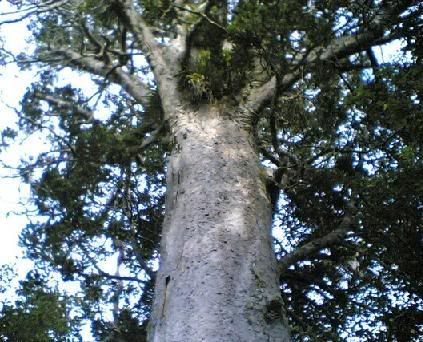Post by bluefedish on Jun 8, 2007 21:41:13 GMT -5
Practical Uses: The canoes, meeting houses & shrines of the Maori were traditionally made of Kauri wood. The resin of this tree, the "gum", was much sought after - the hardened resin was burnt & provided the dye for ceremonial tattoos.
Sadly, during the last 150 years the ancient & majestic Kauri forests of New Zealand's North Island have been reduced from an estimated 4 million acres to barely 18,420 acres.
Culture, Myth, & Symbol: The indigenous people of New Zealand, the Maoris, believe that everything in the natural world, such as trees, animals, birds, insects, & stones, possesses a spirit. At the beginning of time, heaven & earth were one, and among their children was Tane Mahuta, the Supreme Being & Lord of the Forest. When heaven & earth separated, he offered to serve as a column to keep them apart & in balance.
In the forest Maoris consider themselves to be among relative, because they believe that humans & trees are both descendants of Tane. Whenever the younger branch of the family (the humans) have to slay a member of the older branch (a tree) to obtain timber for the building of houses or boats, solemn ceremonies have to be performed. Before this the tohunga - the wise men or priests - take into account the phase of the moon & the spirits of the forest.
An ancient Maori myth expresses the intimate relationship of the kauri with another creature that is essential to Maori life - the whale. From its place inside the forest, the tall Kauri tree observed & admired the whale in the sea. One day, the whale swam to the shore & the giants met & made friends. Each wanted to be with the other but neither of them could leave their own world. So the 2 found another way of expressing their friendship: the whale took off its gray skin & gave it to the Kauri; and the Kauri took off its skin (the bark) & gave it to the whale.
Symbolism: A scared relationship
Astrological Association: Tane Mahuta, Lord of the Forest (Maori)
Historical Spotlight: When Captain Cook "discovered" New Zealand in 1769, he noted enthusiastically, "The banks of the river were completely clothed with the finest timber my eyes have ever seen..."

Selected Source:
The Meaning of Trees by: Fred Hageneder
Sadly, during the last 150 years the ancient & majestic Kauri forests of New Zealand's North Island have been reduced from an estimated 4 million acres to barely 18,420 acres.
Culture, Myth, & Symbol: The indigenous people of New Zealand, the Maoris, believe that everything in the natural world, such as trees, animals, birds, insects, & stones, possesses a spirit. At the beginning of time, heaven & earth were one, and among their children was Tane Mahuta, the Supreme Being & Lord of the Forest. When heaven & earth separated, he offered to serve as a column to keep them apart & in balance.
In the forest Maoris consider themselves to be among relative, because they believe that humans & trees are both descendants of Tane. Whenever the younger branch of the family (the humans) have to slay a member of the older branch (a tree) to obtain timber for the building of houses or boats, solemn ceremonies have to be performed. Before this the tohunga - the wise men or priests - take into account the phase of the moon & the spirits of the forest.
An ancient Maori myth expresses the intimate relationship of the kauri with another creature that is essential to Maori life - the whale. From its place inside the forest, the tall Kauri tree observed & admired the whale in the sea. One day, the whale swam to the shore & the giants met & made friends. Each wanted to be with the other but neither of them could leave their own world. So the 2 found another way of expressing their friendship: the whale took off its gray skin & gave it to the Kauri; and the Kauri took off its skin (the bark) & gave it to the whale.
Symbolism: A scared relationship
Astrological Association: Tane Mahuta, Lord of the Forest (Maori)
Historical Spotlight: When Captain Cook "discovered" New Zealand in 1769, he noted enthusiastically, "The banks of the river were completely clothed with the finest timber my eyes have ever seen..."

Selected Source:
The Meaning of Trees by: Fred Hageneder



